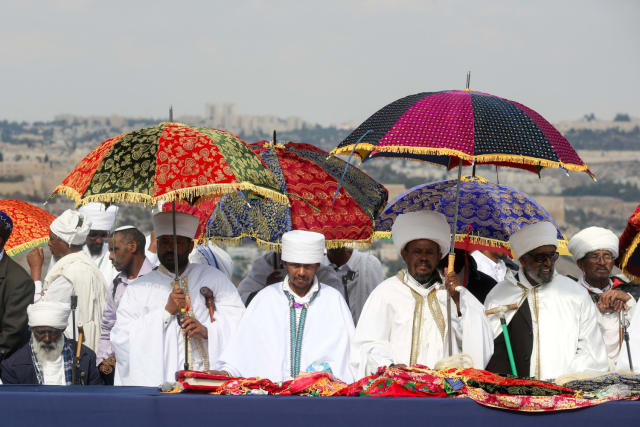
Jewish Holiday
Sigd: What’s It All About?
By Josh Traulsen, Senior Manager of Alumni Engagement & Loren Berman, North American
One of my favorite parts of traveling – and a must-do on any of my trips – is meeting the local Jewish communities in whatever area I visit. It’s amazing how much communities across the world share in common, and yet how some of the smallest differences are the most beautiful.
This past Rosh Hashanah, I found myself with the Ethiopian Jewish communities in Addis Ababa and Gondar. Today, there are around 8,000 Jews in Ethiopia (and growing, it seems), many of whom are learning Hebrew and Jewish text and ritual from the Israeli volunteers who are present year-round. Why might these volunteers be so active there, of all places, and the Ethiopian Jews so receptive to the learning (unlike most of our Jewish day schools and Hebrew schools, let’s be honest)? One primary driver is: the burning desire to move to Israel and reunite with both their biological and spiritual family members.
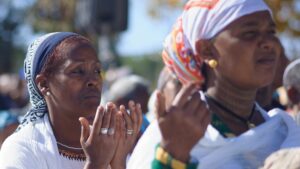 Beyond immigration and bureaucratic complications, moving to Israel raises another major question: When moving to Israel, how does one maintain or change their own people’s Jewish practice, much of which differs from the ‘normative’ rabbinic traditions many of us know? Though many modern Ethopian Jewish practices have come to resemble Rabbinic Judaism – in part due to foreign volunteers and simply wanting to fit in – there is one holiday which stands out as distinctly Ethiopian and is still celebrated by Ethiopians Jews all over the world: Sigd.
Sigd, What’s it all about?
To understand the Ethiopian Jewish holiday of Sigd, you must first know a little about the history of Ethiopian Jews. Sometime between the 1st and 6th centuries, a group of Jewish merchants and artisans settled in the area that would become present-day Ethiopia. Over time, this Jewish community adopted its own traditions and rituals that departed from those of other Jewish communities around the globe. In fact, the existence of the Ethiopian Jews was not widely known in the rest of the Jewish community until the late 1800’s.
In 1867, a French Jewish traveler wrote about a group of Ethiopians he met who called themselves Beta Israel (House of Israel) who followed many of the laws of the Torah including those surrounding ritual purification and also followed the 10 commandments. He found that they had developed their own religious rule structures which included both Kessem (Priests) and secular leaders and kept their Torah in the homes of the Kessem and covered them with bright covered cloth.
In the late 20th Century, Israel managed to bring many thousands of Ethiopian Jews to Israel, but not all of them. This leaves friends and families mostly split between Israel and Ethiopia, with each community developing in its own ways.
Beyond immigration and bureaucratic complications, moving to Israel raises another major question: When moving to Israel, how does one maintain or change their own people’s Jewish practice, much of which differs from the ‘normative’ rabbinic traditions many of us know? Though many modern Ethopian Jewish practices have come to resemble Rabbinic Judaism – in part due to foreign volunteers and simply wanting to fit in – there is one holiday which stands out as distinctly Ethiopian and is still celebrated by Ethiopians Jews all over the world: Sigd.
Sigd, What’s it all about?
To understand the Ethiopian Jewish holiday of Sigd, you must first know a little about the history of Ethiopian Jews. Sometime between the 1st and 6th centuries, a group of Jewish merchants and artisans settled in the area that would become present-day Ethiopia. Over time, this Jewish community adopted its own traditions and rituals that departed from those of other Jewish communities around the globe. In fact, the existence of the Ethiopian Jews was not widely known in the rest of the Jewish community until the late 1800’s.
In 1867, a French Jewish traveler wrote about a group of Ethiopians he met who called themselves Beta Israel (House of Israel) who followed many of the laws of the Torah including those surrounding ritual purification and also followed the 10 commandments. He found that they had developed their own religious rule structures which included both Kessem (Priests) and secular leaders and kept their Torah in the homes of the Kessem and covered them with bright covered cloth.
In the late 20th Century, Israel managed to bring many thousands of Ethiopian Jews to Israel, but not all of them. This leaves friends and families mostly split between Israel and Ethiopia, with each community developing in its own ways.
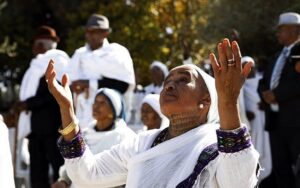 Okay, thanks for the history lesson. What’s the 411 of the holiday?
Okay, thanks for the history lesson. What’s the 411 of the holiday?
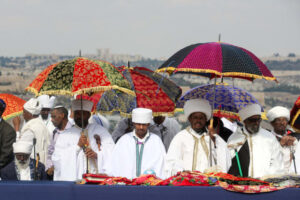 How can you celebrate? *No matter what you do, include input from Jews of Ethiopian descent and try to include them in your planning and program execution!
How can you celebrate? *No matter what you do, include input from Jews of Ethiopian descent and try to include them in your planning and program execution!
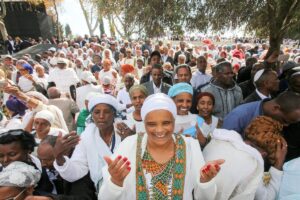 Special thanks to Balaynish and Abere for their contributions to this Schmoozeletter. Check our Rabbi Dr. Sharon Shalom’s “From Sinai to Ethiopia” for more about the history and religious customs and laws of the Ethiopian Jewish Community.
Special thanks to Balaynish and Abere for their contributions to this Schmoozeletter. Check our Rabbi Dr. Sharon Shalom’s “From Sinai to Ethiopia” for more about the history and religious customs and laws of the Ethiopian Jewish Community.
 Beyond immigration and bureaucratic complications, moving to Israel raises another major question: When moving to Israel, how does one maintain or change their own people’s Jewish practice, much of which differs from the ‘normative’ rabbinic traditions many of us know? Though many modern Ethopian Jewish practices have come to resemble Rabbinic Judaism – in part due to foreign volunteers and simply wanting to fit in – there is one holiday which stands out as distinctly Ethiopian and is still celebrated by Ethiopians Jews all over the world: Sigd.
Sigd, What’s it all about?
To understand the Ethiopian Jewish holiday of Sigd, you must first know a little about the history of Ethiopian Jews. Sometime between the 1st and 6th centuries, a group of Jewish merchants and artisans settled in the area that would become present-day Ethiopia. Over time, this Jewish community adopted its own traditions and rituals that departed from those of other Jewish communities around the globe. In fact, the existence of the Ethiopian Jews was not widely known in the rest of the Jewish community until the late 1800’s.
In 1867, a French Jewish traveler wrote about a group of Ethiopians he met who called themselves Beta Israel (House of Israel) who followed many of the laws of the Torah including those surrounding ritual purification and also followed the 10 commandments. He found that they had developed their own religious rule structures which included both Kessem (Priests) and secular leaders and kept their Torah in the homes of the Kessem and covered them with bright covered cloth.
In the late 20th Century, Israel managed to bring many thousands of Ethiopian Jews to Israel, but not all of them. This leaves friends and families mostly split between Israel and Ethiopia, with each community developing in its own ways.
Beyond immigration and bureaucratic complications, moving to Israel raises another major question: When moving to Israel, how does one maintain or change their own people’s Jewish practice, much of which differs from the ‘normative’ rabbinic traditions many of us know? Though many modern Ethopian Jewish practices have come to resemble Rabbinic Judaism – in part due to foreign volunteers and simply wanting to fit in – there is one holiday which stands out as distinctly Ethiopian and is still celebrated by Ethiopians Jews all over the world: Sigd.
Sigd, What’s it all about?
To understand the Ethiopian Jewish holiday of Sigd, you must first know a little about the history of Ethiopian Jews. Sometime between the 1st and 6th centuries, a group of Jewish merchants and artisans settled in the area that would become present-day Ethiopia. Over time, this Jewish community adopted its own traditions and rituals that departed from those of other Jewish communities around the globe. In fact, the existence of the Ethiopian Jews was not widely known in the rest of the Jewish community until the late 1800’s.
In 1867, a French Jewish traveler wrote about a group of Ethiopians he met who called themselves Beta Israel (House of Israel) who followed many of the laws of the Torah including those surrounding ritual purification and also followed the 10 commandments. He found that they had developed their own religious rule structures which included both Kessem (Priests) and secular leaders and kept their Torah in the homes of the Kessem and covered them with bright covered cloth.
In the late 20th Century, Israel managed to bring many thousands of Ethiopian Jews to Israel, but not all of them. This leaves friends and families mostly split between Israel and Ethiopia, with each community developing in its own ways.
 Okay, thanks for the history lesson. What’s the 411 of the holiday?
Okay, thanks for the history lesson. What’s the 411 of the holiday?
-
- What: Sigd literally means “prostration,” and is also known as Mahlele, which is related to the word, Halleluyah, or praise. The holiday’s significance is historical, theological, and communal. Sigd:
- Recalls the giving of the Torah on Mount Sinai,
-
-
- Commemorates the renewal of the covenant by the Jews who returned to Jerusalem,
- Serves as a reminder for those Ethiopians still in exile of the importance of maintaining the tradition, no matter how difficult, and
- Leads to a reconciliation between individuals.
- When (and Why?!): Sigd takes place 50 days after Yom Kippur (on the 29th of Cheshvan). It’s no coincidence. One of the most powerful elements of Sigd is the communal gathering and united celebration. In the Ethiopian tradition, personal atonement on Yom Kippur is not enough to foster peace; after all, tradition says it’s due to the breakdown of interpersonal relations that led to the Jewish exile. Therefore, there are 7 weeks (50 days) given after the personal fasting and repenting for the collective to come together and put the lessons of Yom Kippur into practice. Only then can the communal celebration of Sigd happen. Incidentally, there are 50 days between Passover and Shavuot (when the rabbinic tradition says the Torah was revealed) and this period was actually known as a time of interpersonal strife as well!
-
- Main rituals (we’ll include 6):
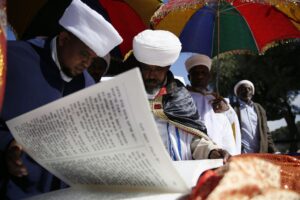
-
- Traditionally, in Ethiopia, Jews would walk to the highest point on a mountain to reenact the giving of the Torah. And this wasn’t in their backyard: Thousands of Jews would travel over 400 miles on foot from Gondar to the village of Ambober to celebrate. Meeting on a high point was both a reenactment of revelation, as well as a marker of sacred space.
- Before making their way towards the mountain, all ritually immerse in the river and put on clean holiday clothing.
- On the mountain, the Kessem (like the Cohens/Priests) carry the Orit (Torah) with them, which is written in the holy language of Geez, not Hebrew, and read from it. They also read from the Biblical book of Nehemiah (as well as Leviticus and Deuteronomy), which describes the reacceptance of the Torah before building the Second Temple.
- The community engages in a structured prayer, in which includes everyone asks for forgiveness for their sins and prostrates themselves on the ground. The shofar is then blown and they say “Just as we have merited celebrating the holiday this year, so may we merit celebrating it next year in Jerusalem.” Le-shanah ha-baah bi-rushalayim!
- Like Yom Kippur, Sigd is a fast day. At least until they climb down the mountains and feast and dance in a Passover seder-like celebration.
- These days, many of these customs are still carried out, but the community in Israel has relocated: The community in Israel climbs up to Mount Zion to do the recitation of the Torah, and then the Kotel (Western Well). Many also hold the ceremony on a promenade in Jerusalem.
 How can you celebrate? *No matter what you do, include input from Jews of Ethiopian descent and try to include them in your planning and program execution!
How can you celebrate? *No matter what you do, include input from Jews of Ethiopian descent and try to include them in your planning and program execution!
-
- Invite a Jew of Ethiopian descent to share the holiday with your community! Perhaps they live in the area, are a visiting student, or are there as part of an Israeli delegation. It’s a great opportunity not only to learn about Sigd, but to learn about navigating Jewish identity. If you aren’t sure who in your neighborhood might be able to come and speak, then email your Regional Jewish Educator or MHWOW contact and we would be happy to help do the networking for you!
- Host a Shabbat dinner with Ethiopian food (including Tej for kiddush, which is local honey wine, and plenty of Ethiopian coffee) and share stories of the thousands Jews who trekked through the desert under nothing but stars and moons on their way to Israel. A Gallery Walk with pictures of individuals with their stories is a plus!
- The North American Conference on Ethiopian Jewry is a great organization trying to improve the lives of Ethiopian Jews through after school programs, supporting entrepreneurship, and providing holiday meals. Try teaming up with them for a Tikkun Olam project!
- Is there a Sigd celebration near you? Look it up! If so, bring your community members!
- Instead of Challah baking, try making Injera or Dah-bo, two different types of Ethiopian bread.
- What are some of your great ideas?
 Special thanks to Balaynish and Abere for their contributions to this Schmoozeletter. Check our Rabbi Dr. Sharon Shalom’s “From Sinai to Ethiopia” for more about the history and religious customs and laws of the Ethiopian Jewish Community.
Special thanks to Balaynish and Abere for their contributions to this Schmoozeletter. Check our Rabbi Dr. Sharon Shalom’s “From Sinai to Ethiopia” for more about the history and religious customs and laws of the Ethiopian Jewish Community.